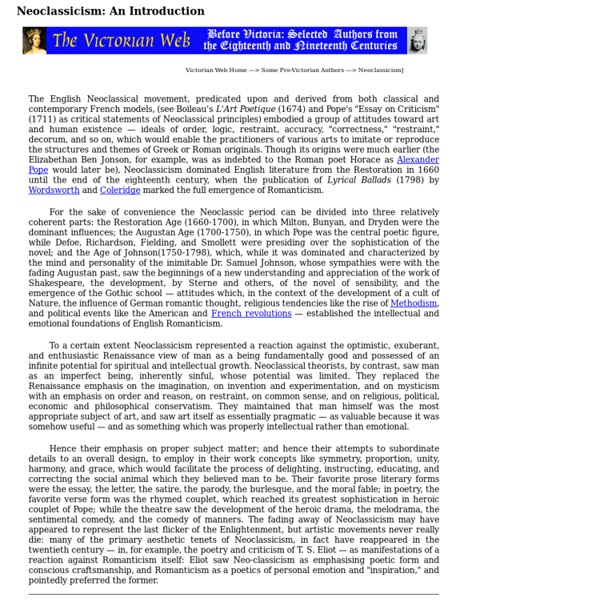Neoclassicism, an introduction | Neo-Classicism
Nicolas Poussin, Et in Arcadia Ego, 1637-38, oil on canvas, 185 cm × 121 cm (72.8 in × 47.6 in) (Louvre) In opposition to the frivolous sensuality of Rococo painters like Jean-Honoré Fragonard and François Boucher, the Neoclassicists looked back to the French painter Nicolas Poussin for their inspiration (Poussin's work exemplifies the interest in classicism in French art of the 17th century ). The decision to promote "Poussiniste" painting became an ethical consideration—they believed that strong drawing was rational, therefore morally better. They believed that art should be cerebral, not sensual. The Neoclassicists, such as Jacques-Louis David (pronounced Da-VEED), preferred the well-delineated form—clear drawing and modeling (shading). France was on the brink of its first revolution in 1789, and the Neoclassicists wanted to express a rationality and seriousness that was fitting for their times. Essay by Dr. Additional resources:
Neoclassicism and America 1750-1900 - What Is Neoclassicism?
What is Neoclassicism? In all realms Neoclassicism admired order, simplicity, clarity, and reason set in a mood of quiet grandeur. It used classical exempla as guides. It left a plentiful record of observations, reflections, and designs in books, essays and folios. It asserted its intentions in clear, detailed, and often majestic prose. It conveyed in precise and elegant language its theory and practice, its means of thought and execution, and its progress as an idea and institutional force. Neoclassicism constituted a revived interest in classical forms and ideas that saturated European and American intellectual thought, fine arts and politics during the 18th and 19th centuries, replete with conscious efforts to imitate and build on the glory of the ancients. American Neoclassicism was a channel of English interest in Roman antiquity, spurred by the Grand Tour and archaeological discoveries. For more on the impact of classical imagery on American thought For more about Johann Winckelmann
Neoclassicism | arts
main referencein the arts, historical tradition or aesthetic attitudes based on the art of Greece and Rome in antiquity. In the context of the tradition, Classicism refers either to the art produced in antiquity or to later art inspired by that of antiquity; Neoclassicism always refers to the art produced later but inspired by antiquity. Thus the terms Classicism and Neoclassicism are often used...architectureThe classicism that flourished in the period 1750–1830 is often known as “Neoclassicism,” in order to distinguish it, perhaps unnecessarily, from the Classical architecture of ancient Rome or of the Renaissance. The search for intellectual and architectural truth characterized the period.
Neoclassicism
Neoclassicism was a movement that affected all art movements including architecture and came about because of many influences of the time. People were tired of the gaudiness, frivolity and innateness of the Rococo movement, and the archaeological findings during this century of the ancient Greek and Roman empires began to influence the art movements again. Some anti Rococo influences in architecture can be detected as early as the 18th century as noted in the Palladin architecture of and . Although the movement began in , and continued on to , , it soon spread throughout the world. This architecture is noted for its strength, its classical lines, its simple characteristics, and much is modeled after the Roman fashion. In architects like Charles Perret even moved the column architecture into functional factory buildings. By the mid 19th centuries cities like and were literally transformed into neoclassical cities. Other noted buildings were The National Gallery in and the of .
Neoclassical Literature: Definition, Characteristics & Movement
Neoclassical literature was written between 1660 and 1798. It was a time of both formality and artificiality. In this lesson, we will examine the characteristics and literature of this time period. Explore our library of over 10,000 lessons Click "next lesson" whenever you finish a lesson and quiz. You now have full access to our lessons and courses. You're 25% of the way through this course! The first step is always the hardest! Way to go! Congratulations on earning a badge for watching 10 videos but you've only scratched the surface. You've just watched 20 videos and earned a badge for your accomplishment! You've just earned a badge for watching 50 different lessons. You just watched your 100th video lesson. Congratulations! Congratulations! You are a superstar! Incredible. You have earned a badge for watching 20 minutes of lessons. You have earned a badge for watching 50 minutes of lessons. You have earned a badge for watching 100 minutes of lessons.



